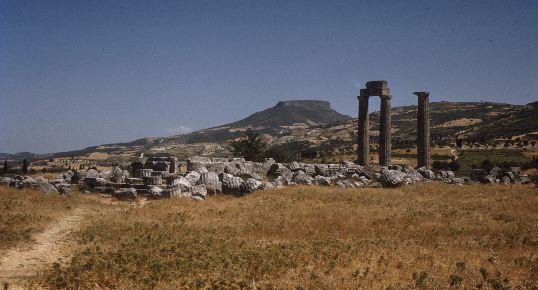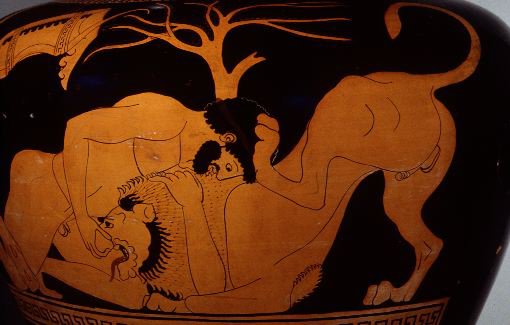The Nemean Lion
Initially, Hercules was required to complete ten labors, not twelve. King Eurystheus decided Hercules' first task would be to bring him the skin of an invulnerable lion which terrorized the hills around Nemea.

Nemea, Temple of Zeus and landscape
Overall view from SW
Photograph courtesy of the Department of Archaeology, Boston University, Saul S. Weinberg Collection
Setting out on such a seemingly impossible labor, Hercules came to a town called Cleonae, where he stayed at the house of a poor workman-for-hire, Molorchus. When his host offered to sacrifice an animal to pray for a safe lion hunt, Hercules asked him to wait 30 days. If the hero returned with the lion's skin, they would sacrifice to Zeus, king of the gods. If Hercules died trying to kill the lion, Molorchus agreed to sacrifice instead to Hercules, as a hero.

Hercules wrestling the Nemean Lion
Philadelphia L-64-185, Attic red figure stamnos, ca. 490 B.C.
Photograph by Maria Daniels, courtesy of the University of Pennsylvania Museum
When Hercules got to Nemea and began tracking the terrible lion, he soon discovered his arrows were useless against the beast. Hercules picked up his club and went after the lion. Following it to a cave which had two entrances, Hercules blocked one of the doorways, then approached the fierce lion through the other. Grasping the lion in his mighty arms, and ignoring its powerful claws, he held it tightly until he'd choked it to death.

Hercules wrestling the Nemean lion
Mississippi 1977.3.62, Attic black figure neck amphora, ca. 510-500 B.C.
Photograph by Maria Daniels, courtesy of the University Museums, University of Mississippi
Hercules returned to Cleonae, carrying the dead lion, and found Molorchus on the 30th day after he'd left for the hunt. Instead of sacrificing to Hercules as a dead man, Molorchus and Hercules were able to sacrifice together, to Zeus.
When Hercules made it back to Mycenae, Eurystheus was amazed that the hero had managed such an impossible task. The king became afraid of Hercules, and forbade him from entering through the gates of the city. Furthermore, Eurystheus had a large bronze jar made and buried partway in the earth, where he could hide from Hercules if need be. After that, Eurystheus sent his commands to Hercules through a herald, refusing to see the powerful hero face to face.

Hercules wearing the lion skin
Boston 99.538, Attic bilingual amphora, ca. 525-500 B.C.
Photograph courtesy,Museum of Fine Arts, Boston. H. L. Pierce Fund
Many times we can identify Hercules in ancient Greek vase paintings or sculptures simply because he is depicted wearing a lion skin. Ancient writers disagreed as to whether the skin Hercules wore was that of the Nemean lion, or one from a different lion, which Hercules was said to have killed when he was 18 years old. The playwright Euripides wrote that Hercules' lion skin came from the grove of Zeus, the sanctuary at Nemea:
|
First he cleared the grove of Zeus of a lion, and put its skin upon his back, hiding his yellow hair in its fearful tawny gaping jaws.
Euripides, Hercules, 359 |
(md)
To read more about these topics, see Further Resources.
- Labor 1: The Nemean Lion
- Labor 2: The Lernean Hydra
- Labor 3: The Hind of Ceryneia
- Labor 4: The Erymanthean Boar
- Labor 5: The Augean Stables
- Labor 6: The Stymphalian Birds
- Labor 7: The Cretan Bull
- Labor 8: The Horses of Diomedes
- Labor 9: The Belt of Hippolyte
- Labor 10: Geryon's Cattle
- Labor 11: The Apples of the Hesperides
- Labor 12: Cerberus
This exhibit is a subset of materials from the Perseus Project digital library and is copyrighted. Please send us your comments.